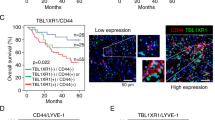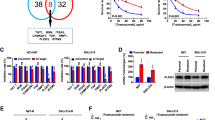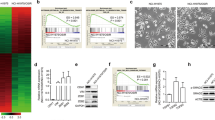Abstract
Human epidermal growth factor receptor 2 (HER2)-directed treatment using trastuzumab has shown clinical benefit in HER2-positive gastric cancer. Clinical trials using lapatinib in HER2-positive gastric cancer are also currently underway. As with other molecularly targeted agents, the emergence of acquired resistance to HER2-directed treatment is an imminent therapeutic problem for HER2-positive gastric cancer. In order to investigate the mechanisms of acquired resistance to HER2-directed treatment in gastric cancer, we generated lapatinib-resistant gastric cancer cell lines (SNU216 LR) in vitro by chronic exposure of a HER2-positive gastric cancer cell line (SNU216) to lapatinib. The resultant SNU216 LR cells were also resistant to gefitinib, cetuximab, trastuzumab, afatinib and dacomitinib. Interestingly, SNU216 LR cells displayed an epithelial–mesenchymal transition (EMT) phenotype and maintained the activation of MET, HER3, Stat3, Akt and mitogen-activated protein kinase signaling in the presence of lapatinib. Using gene expression arrays, we identified the upregulation of a variety of EMT-related genes and extracellular matrix molecules, such as Testican-1, in SNU216 LR cells. We showed that the inhibition of Testican-1 by small interfering RNA decreased Testican-1-induced, MET-dependent, downstream signaling, and restored sensitivity to lapatinib in these cells. Furthermore, treatment with XAV939 selectively inhibited β-catenin-mediated transcription and Testican-1-induced EMT signaling, leading to G1 arrest. Taken together, these data support the potential role of EMT in acquired resistance to HER2-directed treatment in HER2-positive gastric cancer, and provide insights into strategies for preventing and/or overcoming this resistance in patients.
This is a preview of subscription content, access via your institution
Access options
Subscribe to this journal
Receive 50 print issues and online access
$259.00 per year
only $5.18 per issue
Buy this article
- Purchase on Springer Link
- Instant access to full article PDF
Prices may be subject to local taxes which are calculated during checkout





Similar content being viewed by others
References
Gravalos C, Jimeno A . HER2 in gastric cancer: a new prognostic factor and a novel therapeutic target. Ann Oncol 2008; 19: 1523–1529.
Hofmann M, Stoss O, Shi D, Buttner R, van de Vijver M, Kim W et al. Assessment of a HER2 scoring system for gastric cancer: results from a validation study. Histopathology 2008; 52: 797–805.
Tanner M, Hollmen M, Junttila TT, Kapanen AI, Tommola S, Soini Y et al. Amplification of HER-2 in gastric carcinoma: association with Topoisomerase IIalpha gene amplification, intestinal type, poor prognosis and sensitivity to trastuzumab. Ann Oncol 2005; 16: 273–278.
Bang YJ, Van Cutsem E, Feyereislova A, Chung HC, Shen L, Sawaki A et al. Trastuzumab in combination with chemotherapy versus chemotherapy alone for treatment of HER2-positive advanced gastric or gastro-oesophageal junction cancer (ToGA): a phase 3, open-label, randomised controlled trial. Lancet 2010; 376: 687–697.
Kim JW, Kim HP, Im SA, Kang S, Hur HS, Yoon YK et al. The growth inhibitory effect of lapatinib, a dual inhibitor of EGFR and HER2 tyrosine kinase, in gastric cancer cell lines. Cancer Lett 2008; 272: 296–306.
Kim HP, Yoon YK, Kim JW, Han SW, Hur HS, Park J et al. Lapatinib, a dual EGFR and HER2 tyrosine kinase inhibitor, downregulates thymidylate synthase by inhibiting the nuclear translocation of EGFR and HER2. PloS One 2009; 4: e5933.
GlaxoSmithKline, Lapatinib Optimization Study in ErbB2 (HER2) positive gastric cancer: a phase III global, blinded study designed to evaluate clinical endpoints and safety of chemotherapy plus lapatinib [monograph on the Internet]. Bethesda, MD: NIH; 2011. [Cited Oct. 2011]. Available from: http://clinicaltrials.gov/ct2/show/NCT00680901.
Rusnak DW, Alligood KJ, Mullin RJ, Spehar GM, Arenas-Elliott C, Martin AM et al. Assessment of epidermal growth factor receptor (EGFR, ErbB1) and HER2 (ErbB2) protein expression levels and response to lapatinib (Tykerb, GW572016) in an expanded panel of human normal and tumour cell lines. Cell Prolif 2007; 40: 580–594.
Yauch RL, Januario T, Eberhard DA, Cavet G, Zhu W, Fu L et al. Epithelial versus mesenchymal phenotype determines in vitro sensitivity and predicts clinical activity of erlotinib in lung cancer patients. Clin Cancer Res 2005; 11: 8686–8698.
Thomson S, Buck E, Petti F, Griffin G, Brown E, Ramnarine N et al. Epithelial to mesenchymal transition is a determinant of sensitivity of non-small-cell lung carcinoma cell lines and xenografts to epidermal growth factor receptor inhibition. Cancer Res 2005; 65: 9455–9462.
Witta SE, Gemmill RM, Hirsch FR, Coldren CD, Hedman K, Ravdel L et al. Restoring E-cadherin expression increases sensitivity to epidermal growth factor receptor inhibitors in lung cancer cell lines. Cancer Res 2006; 66: 944–950.
Lee MS, Kim HP, Kim TY and Lee JW . Gefitinib resistance of cancer cells correlated with TM4SF5-mediated epithelial-mesenchymal transition. Biochim Biophys Acta 2012; 1823: 514–523.
Wang Z, Li Y, Kong D, Banerjee S, Ahmad A, Azmi AS et al. Acquisition of epithelial-mesenchymal transition phenotype of gemcitabine-resistant pancreatic cancer cells is linked with activation of the notch signaling pathway. Cancer Res 2009; 69: 2400–2407.
Chang TH, Tsai MF, Su KY, Wu SG, Huang CP, Yu SL et al. Slug confers resistance to the epidermal growth factor receptor tyrosine kinase inhibitor. Am J Respir Crit Care Med 2011; 183: 1071–1079.
Thiery JP . Epithelial-mesenchymal transitions in tumour progression. Nat Rev Cancer 2002; 2: 442–454.
Thiery JP, Acloque H, Huang RY and Nieto MA . Epithelial-mesenchymal transitions in development and disease. Cell 2009; 139: 871–890.
Edgell CJ, BaSalamah MA and Marr HS . Testican-1: a differentially expressed proteoglycan with protease inhibiting activities. Int Rev Cytol 2004; 236: 101–122.
Wlazlinski A, Engers R, Hoffmann MJ, Hader C, Jung V, Muller M et al. Downregulation of several fibulin genes in prostate cancer. Prostate 2007; 67: 1770–1780.
Prenzel KL, Warnecke-Eberz U, Xi H, Brabender J, Baldus SE, Bollschweiler E et al. Significant overexpression of SPARC/osteonectin mRNA in pancreatic cancer compared to cancer of the papilla of Vater. Oncol Rep 2006; 15: 1397–1401.
Li Y, Chen L, Chan TH, Liu M, Kong KL, Qiu JL et al. SPOCK1 is regulated by CHD1L and blocks apoptosis and promotes HCC cell invasiveness and metastasis in mice. Gastroenterology 2013; 144: 179–191.
Leja J, Essaghir A, Essand M, Wester K, Oberg K, Totterman TH et al. Novel markers for enterochromaffin cells and gastrointestinal neuroendocrine carcinomas. Mod Pathol 2009; 22: 261–272.
Engelman JA, Zejnullahu K, Mitsudomi T, Song Y, Hyland C, Park JO et al. MET amplification leads to gefitinib resistance in lung cancer by activating ERBB3 signaling. Science 2007; 316: 1039–1043.
Kim SY, Kim HP, Kim YJ, Oh do Y, Im SA, Lee D et al. Trastuzumab inhibits the growth of human gastric cancer cell lines with HER2 amplification synergistically with cisplatin. Int J Oncol 2008; 32: 89–95.
Nam HJ, Kim HP, Yoon YK, Hur HS, Song SH, Kim MS et al. Antitumor activity of HM781-36B, an irreversible Pan-HER inhibitor, alone or in combination with cytotoxic chemotherapeutic agents in gastric cancer. Cancer Lett 2011; 302: 155–165.
Klaus A, Birchmeier W . Wnt signalling and its impact on development and cancer. Nat Rev Cancer 2008; 8: 387–398.
White BD, Chien AJ, Dawson DW . Dysregulation of Wnt/beta-catenin signaling in gastrointestinal cancers. Gastroenterology 2012; 142: 219–232.
Huang SM, Mishina YM, Liu S, Cheung A, Stegmeier F, Michaud GA et al. Tankyrase inhibition stabilizes axin and antagonizes Wnt signalling. Nature 2009; 461: 614–620.
Liu L, Greger J, Shi H, Liu Y, Greshock J, Annan R et al. Novel mechanism of lapatinib resistance in HER2-positive breast tumor cells: activation of AXL. Cancer Res 2009; 69: 6871–6878.
Chen FL, Xia WandSpector NL . Acquired resistance to small molecule ErbB2 tyrosine kinase inhibitors. Clin Cancer Res 2008; 14: 6730–6734.
Xia W, Bacus S, Hegde P, Husain I, Strum J, Liu L et al. A model of acquired autoresistance to a potent ErbB2 tyrosine kinase inhibitor and a therapeutic strategy to prevent its onset in breast cancer. Proc Natl Acad Sci USA 2006; 103: 7795–7800.
Nahta R, Yuan LX, Du Y and Esteva FJ . Lapatinib induces apoptosis in trastuzumab-resistant breast cancer cells: effects on insulin-like growth factor I signaling. Mol Cancer Ther 2007; 6: 667–674.
Berns K, Horlings HM, Hennessy BT, Madiredjo M, Hijmans EM, Beelen K et al. A functional genetic approach identifies the PI3K pathway as a major determinant of trastuzumab resistance in breast cancer. Cancer Cell 2007; 12: 395–402.
Nagata Y, Lan KH, Zhou X, Tan M, Esteva FJ, Sahin AA et al. PTEN activation contributes to tumor inhibition by trastuzumab, and loss of PTEN predicts trastuzumab resistance in patients. Cancer Cell 2004; 6: 117–127.
Xia W, Husain I, Liu L, Bacus S, Saini S, Spohn J et al. Lapatinib antitumor activity is not dependent upon phosphatase and tensin homologue deleted on chromosome 10 in ErbB2-overexpressing breast cancers. Cancer Res 2007; 67: 1170–1175.
Colleoni M, Viale G, Zahrieh D, Bottiglieri L, Gelber RD, Veronesi P et al. Expression of ER, PgR, HER1, HER2, and response: a study of preoperative chemotherapy. Ann oncol 2008; 19: 465–472.
Guo S, Sonenshein GE . Forkhead box transcription factor FOXO3a regulates estrogen receptor alpha expression and is repressed by the Her-2/neu/phosphatidylinositol 3-kinase/Akt signaling pathway. MolCell Biol 2004; 24: 8681–8690.
Sergina NV, Rausch M, Wang D, Blair J, Hann B, Shokat KM et al. Escape from HER-family tyrosine kinase inhibitor therapy by the kinase-inactive HER3. Nature 2007; 445: 437–441.
Xia W, Liu LH, Ho PandSpector NL . Truncated ErbB2 receptor (p95ErbB2) is regulated by heregulin through heterodimer formation with ErbB3 yet remains sensitive to the dual EGFR/ErbB2 kinase inhibitor GW572016. Oncogene 2004; 23: 646–653.
Anido J, Scaltriti M, Bech Serra JJ, Santiago Josefat B, Todo FR, Baselga J et al. Biosynthesis of tumorigenic HER2 C-terminal fragments by alternative initiation of translation. EMBO J 2006; 25: 3234–3244.
Scaltriti M, Rojo F, Ocana A, Anido J, Guzman M, Cortes J et al. Expression of p95HER2, a truncated form of the HER2 receptor, and response to anti-HER2 therapies in breast cancer. J Natl Cancer Inst 2007; 99: 628–638.
Acknowledgements
This work was supported by grants from the Korean Healthcare 21 and Technology R&D Project; Ministry for Health, Welfare and Family Affairs (A091081) and in part by the Priority Research Centers Program through the National Research Foundation of Korea (NRF) funded by the Ministry of Education, Science and Technology (2009-0093820).
Author information
Authors and Affiliations
Corresponding author
Ethics declarations
Competing interests
The authors declare no conflict of interest.
Additional information
Supplementary Information accompanies this paper on the Oncogene website
Rights and permissions
About this article
Cite this article
Kim, HP., Han, SW., Song, SH. et al. Testican-1-mediated epithelial–mesenchymal transition signaling confers acquired resistance to lapatinib in HER2-positive gastric cancer. Oncogene 33, 3334–3341 (2014). https://doi.org/10.1038/onc.2013.285
Received:
Revised:
Accepted:
Published:
Issue Date:
DOI: https://doi.org/10.1038/onc.2013.285
Keywords
This article is cited by
-
The critical role of circular RNAs in drug resistance in gastrointestinal cancers
Medical Oncology (2023)
-
Current status and future perspectives in HER2 positive advanced gastric cancer
Clinical and Translational Oncology (2022)
-
SPOCK1 promotes metastasis in pancreatic cancer via NF-κB-dependent epithelial-mesenchymal transition by interacting with IκB-α
Cellular Oncology (2022)
-
Human epidermal growth factor receptor 2 (HER2) in advanced gastric cancer: where do we stand?
Gastric Cancer (2021)
-
SPOCK1 is a novel inducer of epithelial to mesenchymal transition in drug-induced gingival overgrowth
Scientific Reports (2020)



